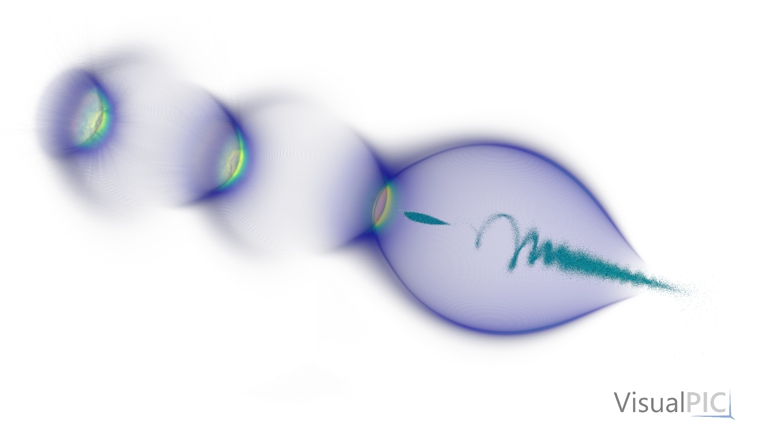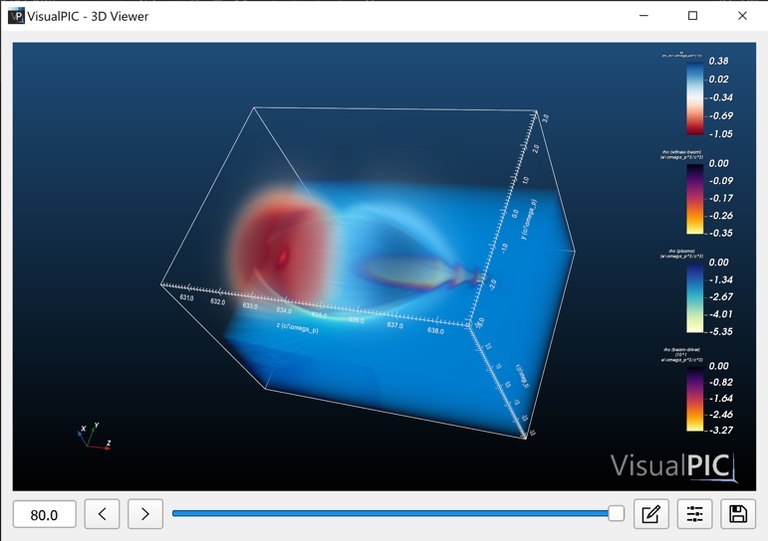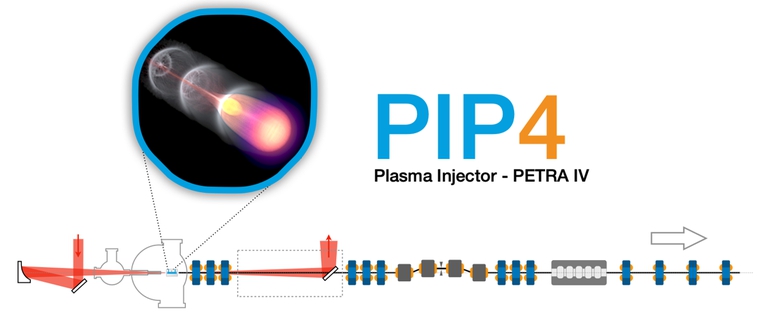Plasma Theory & Simulations
MPA 1
Plasma Accelerators
MPA 1

HiPACE++ simulation of beam-driven plasma acceleration. Credit: DESY, Maxence Thévenet and Angel Ferran Pousa.
Numerical simulations are at the center of plasma acceleration. They help develop and test new concepts, provide insights for theoretical understanding, and support interpretation of experiments. Plasma is a multi-scale state of matter, and the variety of plasma systems (a million kilometers for a star, a few meters for a tokamak plasma, sub-millimeter for plasma acceleration) is matched with a variety of models and simulation methods. The method of choice for plasma (or wakefield) acceleration is called particle-in-cell, which is well-suited for the kinetic plasma behavior observed in a wakefield accelerator.
MPA1 assembles theory and simulation expertise to develop new simulation methods and exploit high-performance computing (HPC) to further our understanding of plasma acceleration and propose concepts to solve domain challenges.
PIP4: Plasma Injector for Petra IV
PETRA IV will be the new storage ring at DESY for low-emittance electron beams at 6 GeV, providing a substantial upgrade in terms of beam quality (two orders of magnitude smaller beam emittance) with respect to PETRA III. The conceptual design study for a Plasma Injector for PETRA IV (PIP4, led by Alberto Martinez de la Ossa) explores the possibility of realizing an alternative, compact injector system based on laser plasma accelerator (LPA) technology, to supply high-quality electron bunches for PETRA IV. Designing an LPA module providing enough charge per second at 6 GeV energy within the PETRA IV acceptance is the primary goal of the project, representing the first attempt to install LPA technology into a world-leading accelerator facility with practical applications in photon science. The PIP4 team gathers experts in plasma and conventional accelerators who develop theoretical concepts and utilize numerical simulations toward a conceptual design.
HiPACE++
HiPACE++ is an open-source GPU-capable 3D quasi-static particle-in-cell code, written in C++, see https://github.com/Hi-PACE/hipace. With a new portability strategy harnessing the power of top supercomputers, HiPACE++ enables simulations 10x faster and orders-of-magnitude cheaper than previous CPU implementations, see https://arxiv.org/abs/2109.10277.

HiPACE++ simulation of beam-driven plasma acceleration. An intense beam of electrons, the driver (light blue, right), propagates near the speed of light in a plasma and expels the plasma electrons from its path. The electron density (dark blue) is perturbed and a "bubble" with no plasma electrons forms behind the driver, where the remaining ions create strong accelerating and focusing fields. Another beam of electrons, the witness (light blue, behind the driver) located in the bubble can be accelerated by these strong fields. Asymmetric effects like the hosing instability (causing the witness beam to oscillate, resulting in this corkscrew shape) require the use of 3D particle-in-cell codes. Credit: DESY, simulation done with HiPACE++ (https://github.com/Hi-PACE/hipace) by Maxence Thévenet and Severin Diederichs on Maxwell (DESY-IT). Rendering done with VisualPIC (https://github.com/AngelFP/VisualPIC) by Maxence Thévenet and Angel Ferran Pousa.
Wake-T

Wake-T simulation of a laser-driven plasma accelerator (LPA). Credit: DESY, Angel Ferran Pousa. Simulation: Wake-T. Visualization: VisualPIC.
Wake-T (Wakefield particle Tracker) is a tracking code for laser- and beam-driven plasma wakefield accelerators which aims at providing a fast alternative to Particle-in-Cell (PIC) simulations. Instead of relying on the computationally-expensive PIC algorithm for simulating the plasma wakefields and the beam evolution, Wake-T uses a Runge-Kutta solver to track the evolution of the beam electrons in the wakefields, which, at the same time, are computed from reduced models. This allows for a significant speed-up of the simulations, which can be performed in a matter of seconds instead or hours/days, with excellent accuracy in quasi-static axisymmetric conditions.
VisualPIC

VisualPIC 3D rendering tool (based on VTK), see https://github.com/AngelFP/VisualPIC. Credit: DESY, Angel Ferran Pousa
VisualPIC is an open-source 3D visualization tool for Particle-In-Cell simulations. It provides a simple and lightweight graphical interface to harness the capabilities of VTK, enabling high-quality 3D rendering in an easy way. It supports scientific data at the openPMD standard, as well as custom format from popular codes such as OSIRIS (http://epp.tecnico.ulisboa.pt/osiris/). More information at https://github.com/AngelFP/VisualPIC.
